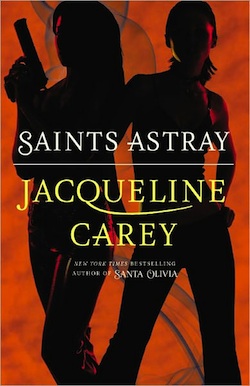Jacqueline Carey is best known for her epic fantasy Kushiel’s Legacy series, but in 2009 she branched out into science fiction with Santa Olivia, a gritty novel about Loup Garron, the daughter of a genetically modified man growing up in a military outpost on the border between the United States and Mexico. This month, Saints Astray, a sequel to Santa Olivia, hits bookstores and picks up the story only minutes later, as Loup and her girlfriend, Pilar, are fleeing the outpost. I asked Jacqueline about her goals for the sequel and her thoughts on one of Loup’s defining characteristics: the fact that she cannot feel fear.
Malinda Lo: I loved Santa Olivia, so I was thrilled to have the chance to interview you about the sequel, Saints Astray. As I’m sure you know, sequels are hard to write; there are so many expectations to deal with! What were your intentions or goals in writing Saints Astray? What kind of story did you aim to tell?
 Jacqueline Carey: I wanted to turn Loup and Pilar loose on the world, and let them experience it with wide-eyed wonder and exuberance! Because their lives in Santa Olivia were so restrictive, everything’s a first for them—staying in a hotel, going to a movie, looking at art, swimming in the ocean, flying on a plane. It was fun to explore their ongoing awe at the world’s vastness. While the overarching theme is one of homecoming and redemption, I also wanted the plot to reflect that sense of joyfulness.
Jacqueline Carey: I wanted to turn Loup and Pilar loose on the world, and let them experience it with wide-eyed wonder and exuberance! Because their lives in Santa Olivia were so restrictive, everything’s a first for them—staying in a hotel, going to a movie, looking at art, swimming in the ocean, flying on a plane. It was fun to explore their ongoing awe at the world’s vastness. While the overarching theme is one of homecoming and redemption, I also wanted the plot to reflect that sense of joyfulness.
Hence, a series of over-the-top capers. There’s a deliberate element of absurdity in these books, and I tried to celebrate it in Saints Astray. After all, it’s about a pair of teenage girls out to change the world.
ML: I think that Loup Garron is a fascinating character. Because of her genetically modified father, she cannot feel fear, and this impacts her behavior in such interesting ways. For example, in Santa Olivia, she isn’t afraid to fall in love with a girl, even though that’s not exactly the norm. It’s the girl she falls in love with who has to deal with fear about it. In Saints Astray, Loup’s girlfriend seems to develop her own fearlessness about their relationship. Your novels have always delved fearlessly into same-sex relationships and obviously you’ve found a devoted audience partly because of this. But have you ever feared that writing about same-sex relationships will limit your audience?
JC: I haven’t, and I’m sure it’s in large part because my debut novel, Kushiel’s Dart, was sufficiently provocative that the fact that it contained significant same-sex relationships wasn’t high on my list of concerns. It was overshadowed by the BDSM elements. Phèdre, the protagonist of the first Kushiel trilogy, is a divinely-touched masochist—and a genuine epic fantasy heroine.
The books are intended to be subversive, not exploitative, but when the launching point for your literary career is a bisexual masochistic courtesan-spy, it sets the bar pretty high in terms of challenging cultural norms. The fact that those books have found such a wonderful, diverse audience encourages me to believe that many, many people are open to reading about the whole complicated, messy, glorious range of human sexuality as long as the characters are engaging and the story is compelling.
To me, the most interesting aspect of Loup’s fearlessness is the impact it has on the people around her. It often acts as a catalyst, prompting them to rise above their own fears. Having her fall in love with the reluctant and ostensibly straight Pilar allowed me to play that out on an intimate personal level in Santa Olivia. By the time we encounter them in Saints Astray, Pilar’s past those fears. She left everything she knew behind to be with Loup. She’s gone all in on the relationship, baby.
ML: Both Saints Astray and Santa Olivia are quite different from your Kushiel series. Stylistically, I’d say that Saints Astray and Santa Olivia are grittier, with punchier prose, whereas the Kushiel series has a more traditional fantasy feel. What drew you to try out this very different way of writing?
JC: It’s funny, because in deference to conventional wisdom, I spent my struggling writer years trying to suppress my naturally baroque literary voice and write clean, spare prose. I finally gave up and embraced my baroque tendencies when I wrote the Kushiel series. But after several thousand pages of ornate literary narrative, I was ready to explore a more succinct, muscular lyricism. As much as I love rich, luxuriant prose, sometimes you need a palate cleanser!
ML: Any plans for more books about Loup? Or are you working on something entirely different now?
JC: I’m working on something new and completely different (my take on urban fantasy), and at this point I don’t have plans for further books about Loup, but as always, never say never.
Malinda Lo, a former entertainment reporter, is the author of Ash and Huntress, two young adult fantasies. She lives in Northern California with her partner and their dog. Visit her website at www.malindalo.com.










